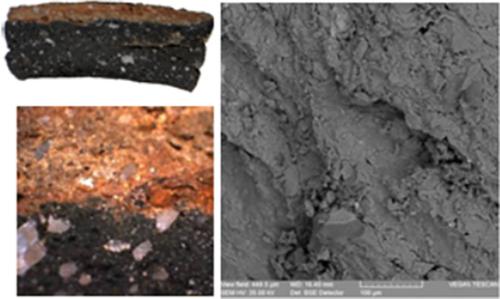当前位置:
X-MOL 学术
›
Microsc. Res. Tech.
›
论文详情
Our official English website, www.x-mol.net, welcomes your
feedback! (Note: you will need to create a separate account there.)
OM, SEM-EDX, and micro-FTIR analysis of the Bronze Age pottery from the Băile Figa salt production site (Transylvania, Romania).
Microscopy Research and Technique ( IF 2.0 ) Pub Date : 2020-01-31 , DOI: 10.1002/jemt.23451 Viorica Vasilache 1 , Valerii Kavruk 1, 2 , Felix-Adrian Tencariu 1
Microscopy Research and Technique ( IF 2.0 ) Pub Date : 2020-01-31 , DOI: 10.1002/jemt.23451 Viorica Vasilache 1 , Valerii Kavruk 1, 2 , Felix-Adrian Tencariu 1
Affiliation

|
This article presents the results of analyses carried out on a lot of 11 fragments of Bronze Age ceramics discovered in the site from Băile Figa (Beclean town, Transylvania, Romania), where salt exploitation occurred. The samples were analyzed by means of optical microscopy, on the basis of which the morphology and distribution of the inclusions in the ceramic paste was established. Likewise, the samples were analyzed by scanning electron microscopy with energy‐dispersive X‐ray spectrometry, producing microphotographs for each sample, and on the basis of the X‐ray spectra, the elemental composition in gravimetric percentages was established. Through the micro‐Fourier‐transform infrared spectroscopy analysis, on the basis of characteristic group vibrations, it was possible to ascertain the nature of the compounds from the ceramic samples. These analyses will contribute to the reconstruction of the prehistoric technologies for salt exploitation.
中文翻译:

使用BăileFiga盐生产厂(罗马尼亚特兰西瓦尼亚)的青铜时代陶器进行OM,SEM-EDX和微型FTIR分析。
本文介绍了对在从BăileFiga(罗马尼亚特兰西瓦尼亚,特兰西瓦尼亚,Beclean镇)发现盐矿的地点发现的11个青铜时代陶瓷碎片进行分析的结果。通过光学显微镜分析样品,在此基础上确定了陶瓷糊中夹杂物的形态和分布。同样,通过能量色散X射线扫描电子显微镜对样品进行分析,为每个样品生成显微照片,并根据X射线光谱确定重量百分数的元素组成。通过微傅里叶变换红外光谱分析,基于特征群振动,可以确定陶瓷样品中化合物的性质。
更新日期:2020-01-31
中文翻译:

使用BăileFiga盐生产厂(罗马尼亚特兰西瓦尼亚)的青铜时代陶器进行OM,SEM-EDX和微型FTIR分析。
本文介绍了对在从BăileFiga(罗马尼亚特兰西瓦尼亚,特兰西瓦尼亚,Beclean镇)发现盐矿的地点发现的11个青铜时代陶瓷碎片进行分析的结果。通过光学显微镜分析样品,在此基础上确定了陶瓷糊中夹杂物的形态和分布。同样,通过能量色散X射线扫描电子显微镜对样品进行分析,为每个样品生成显微照片,并根据X射线光谱确定重量百分数的元素组成。通过微傅里叶变换红外光谱分析,基于特征群振动,可以确定陶瓷样品中化合物的性质。











































 京公网安备 11010802027423号
京公网安备 11010802027423号